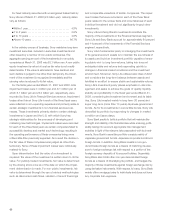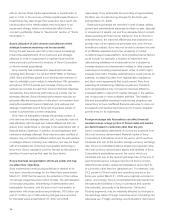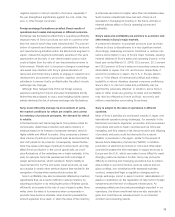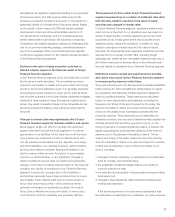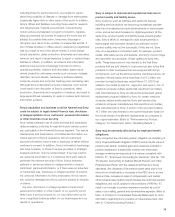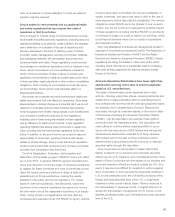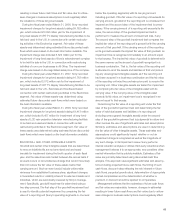Sony 2008 Annual Report Download - page 77
Download and view the complete annual report
Please find page 77 of the 2008 Sony annual report below. You can navigate through the pages in the report by either clicking on the pages listed below, or by using the keyword search tool below to find specific information within the annual report. 75
negative impact on Sony’s results in the future, especially if
the yen strengthens significantly against the U.S. dollar, the
euro or other foreign currencies.
Foreign exchange fluctuations can affect Sony’s results of
operations due to sales and expenses in different currencies.
Exchange rate fluctuations affect Sony’s operating profitability
because many of Sony’s products are sold in countries other
than the ones in which they were manufactured. The concen-
tration of research and development, administrative functions
and manufacturing activities within the Electronics segment in
Japan, makes this segment particularly sensitive to the yen’s
appreciation as the ratio of yen-denominated costs to total
costs is higher than the ratio of yen-denominated revenue to
total revenue. Volatile mid- to long-term changes in exchange
rate levels may interfere with Sony’s global allocation of
resources and hinder Sony’s ability to engage in research and
development, procurement, production, logistics, and sales
activities in a manner that is profitable after the effect of such
exchange rate changes.
Although Sony hedges most of the net foreign currency
exposure resulting from import and export transactions shortly
before they are projected to occur, such hedging activity cannot
entirely eliminate the risk of adverse exchange rate fluctuations.
Sony must efficiently manage its procurement of parts,
the market conditions for which are volatile, and control
its inventory of products and parts, the demand for which
is volatile.
In the Electronics and Game segments, Sony places orders for
components, determines production and plans inventory in
advance based on its forecast of consumer demand, which is
highly volatile and difficult to predict. Sony consumes a tremen-
dous volume of parts and components such as semiconductors
and LCD panels for its products. Consequently, market fluctua-
tions may cause a shortage of parts and components, and may
affect Sony’s production or the cost of goods sold, as could
price fluctuations of the underlying raw or basic materials. In the
past, for example, Sony has experienced both a shortage of
certain semiconductors, which resulted in Sony’s inability to
meet demand for its PCs and audio visual products, as well
as a surplus in certain other semiconductors that resulted in the
recognition of losses when semiconductor prices fell.
Sony’s profitability may also be adversely affected by inventory
adjustments that, as a result of efforts to reduce inventory by
adjusting production or by reducing the price of finished goods,
will lead to an increase in the ratio of cost of sales to sales. Sony
writes down the value of its inventory when components or
products have become obsolete, when inventory exceeds the
amount expected to be used, or when the value of the inventory
is otherwise recorded at a higher value than net realizable value.
Such inventory adjustments have had and, if Sony is not
successful in managing its inventory in the future, will have a
material adverse effect on Sony’s operating income and
profitability.
Sony’s sales and profitability are sensitive to economic and
other trends in Sony’s major markets.
A consumer’s decision to purchase products such as those
offered by Sony is discretionary to a very significant extent.
Accordingly, weakening economic conditions or outlook can
reduce consumption in any of Sony’s major markets, causing
material declines in Sony’s sales and operating income. In the
fiscal year ended March 31, 2008, 23.2 percent, 25.1 percent
and 26.2 percent of Sony’s sales and operating revenue were
attributable to Japan, the U.S. and Europe, respectively. If
economic conditions in Japan, the U.S. or Europe deterio-
rate, or if the effects of international political and military
instability or natural disasters depress consumer confidence,
Sony’s short- to mid-term sales and profitability may be
significantly adversely affected. In addition, since Sony’s
sales in Other Areas are growing, its sales and profitability
may also be affected by future political, economic and
military uncertainties surrounding those areas.
Sony is subject to the risks of operations in different
countries.
Most of Sony’s activities are conducted outside of Japan, and
international operations bring challenges. For example, in the
Electronics and Game segments, production and procurement
of products and parts in Asian countries such as China are
increasing, and this creates a risk that production and shipping
of products and parts could be interrupted by a natural
disaster or pandemic in the region, similar to the spread of
Severe Acute Respiratory Syndrome (“SARS”). In addition,
production of electronics products in China and other Asian
countries increases the time necessary to supply products to
Europe and the U.S., which can make it more difficult to meet
changing customer demand. Further, Sony may encounter
difficulty in planning and managing operations due to unfavor-
able political or economic factors, such as cultural and reli-
gious conflicts, non-compliance with expected business
conduct, unexpected legal or regulatory changes such as
foreign exchange, import or export controls, nationalization of
assets or restrictions on the repatriation of returns from foreign
investments and the lack of adequate infrastructure. As
emerging markets are becoming increasingly important in our
operations, the above mentioned risks are also expected to
grow and could have an adverse impact on our financial
condition and operating results.



